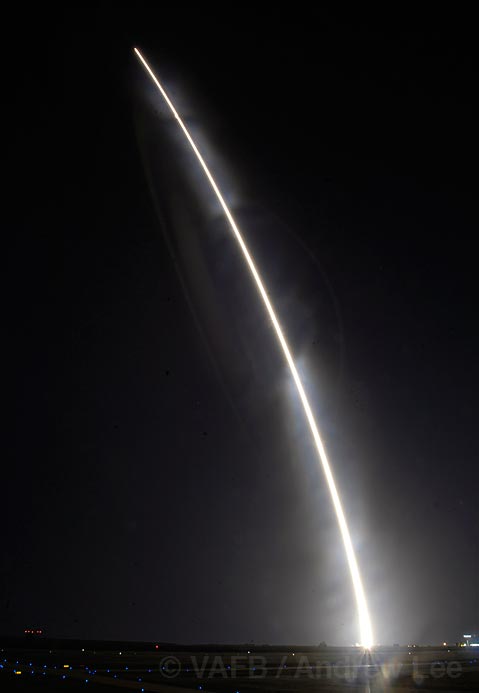Satellite Crashes into Ocean
$279-Million Device Would Have Measured Global Warming
Early Tuesday morning, 325 miles above earth, a carbon-tracking satellite launched from Vandenberg Air Force Base malfunctioned, failed to reach orbiting speed, and fell into the Indian Ocean, near Antarctica.
The satellite’s countdown, timed for liftoff at 1:55 a.m., was troubled by a brief power outage to the emergency termination controls just moments before ignition. After a tense few seconds, power was restored. The Taurus XL rocket then roared into space with apparent ease, attaining an altitude of about 10 miles and a speed of about 2,000 miles per hour in 30 seconds.

A small crowd of press, airmen, officers, and public officials watched the launch from a field four miles away and listened in to a broadcast from the control room. After successfully deploying four successive rocket engines, the satellite was nearly ready for orbit, but had to shed its protective nosecone. This hard shell, which protected the satellite’s delicate instruments from the hazards of the launch, was designed to be jettisoned once the satellite reached space. Four explosive bolts that held the vertical seal together were detonated successfully, but four similar bolts designed to separate the satellite from its base failed to fire. The satellite lost speed and fell to earth.
“For the science community, it’s a huge disappointment,” said John Brunschwyler, program manager for the Taurus XL rocket, which was built by the Virginia-based Orbital Sciences Corporation (OSC).
The satellite-called the Orbiting Carbon Observatory and also built by OSC-would have aided the study of global warming, specifically the tendency for oceans or forests to absorb a differing amount of carbon from year to year. This difference between the “good” and “bad” years can add up to as much as 2.4 billion tons of additional carbon in the atmosphere. If imagined as a cube 1.5 miles square, such an amount of carbon could easily flatten Santa Barbara. If this carbon was burned and remained in the atmosphere as carbon dioxide, instead of being reabsorbed as it mostly is at present, it would be enough to raise the overall level of carbon dioxide in the atmosphere by 33 percent, to nearly 500 parts per million, which some scientists believe would be the end of civilization as we know it.
Scott Denning, who leads the scientific team on the mission, said over the phone from his office at Colorado State, “No matter where you think the tipping point is-whether you think it’s at 450 parts per million or much higher-we need to know what is happening with this carbon, in order to know how close we are to a crisis.”
The satellite was intended to continuously measure concentrations of carbon dioxide around the entire globe in precise detail, which would be used with existing ground-based measurements to create a much more precise picture of the flows of carbon dioxide in the atmosphere. The two-year mission for the phone booth-sized satellite was budgeted at $279 million. To date, the mission has cost an estimated $240 million, said Jet Propulsion Laboratory spokesperson Alan Buis.
Michael Frelich, who directs NASA’s Earth Science Division, could not predict if the agency would decide to rebuild the satellite, or if the agency would rely on data from existing satellites and GOSAT (Greenhouse Gases Observing Satellite), a Japanese mission launched last month. GOSAT is already measuring the density of carbon dioxide and methane in the atmosphere.
Launch director Chuck Dovale said that NASA will learn from this mission nonetheless. He promised that within 24 hours of the failure, a chairman would be named to lead a board of investigators into the launch failure. “Our goal will be to find a root cause for this problem, and we won’t fly again until we have that data,” Dovale said.



